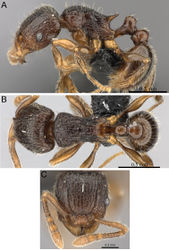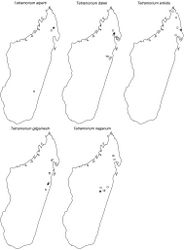Tetramorium enkidu
| Notice: | This page is derived from the original publication listed below, whose author(s) should always be credited. Further contributors may edit and improve the content of this page and, consequently, need to be credited as well (see page history). Any assessment of factual correctness requires a careful review of the original article as well as of subsequent contributions.
If you are uncertain whether your planned contribution is correct or not, we suggest that you use the associated discussion page instead of editing the page directly. This page should be cited as follows (rationale):
Citation formats to copy and paste
BibTeX: @article{Hita2014ZooKeys413, RIS/ Endnote: TY - JOUR Wikipedia/ Citizendium: <ref name="Hita2014ZooKeys413">{{Citation See also the citation download page at the journal. |
Ordo: Hymenoptera
Familia: Formicidae
Genus: Tetramorium
Name
Tetramorium enkidu Hita Garcia & Fisher sp. n. – Wikispecies link – ZooBank link – Pensoft Profile
Type material
Holotype, pinned worker, MADAGASCAR, Antsiranana, Forêt Ambanitaza, 26.1 km 347° Antalaha, 14.67933°S, 50.18367°E, 240 m, rainforest, sifted litter (leaf mold, rotten wood), collection code BLF10997, 26.XI.2004 (B.L. Fisher) (CAS: CASENT0056450). Paratypes, ten pinned workers with same data as holotype (BMNH: CASENT0056445; CAS: CASENT0056435; CASENT0056436; CASENT0056437; CASENT0056441; CASENT0056448; CASENT0056449; CASENT0056456; CASENT0056467; MCZ: CASENT0056461).
Non-type material
Antsiranana, Forêt Ambanitaza, 26.1 km 347° Antalaha, 14.6793°S, 50.1837°E, 240 m, rainforest, 26.XI.2004 (B.L. Fisher); Antsiranana, 1 km W Andampibe, Cap Masoala, 15.6936°S, 50.1814°E, 125 m, lowland rainforest, 1.XII.1993 (G.D. Alpert); Antsiranana, Forêt de Binara, 9.4km 235° SW Daraina, 13.2633°S, 49.6°E, 1100 m, montane rainforest, 5.XII.2003 (B.L. Fisher); Antsiranana, Parc National Montagne d’Ambre, 3.6 km 235° SW Joffreville, 12.5344°S, 49.1795°E, 925 m, montane rainforest, 20.–26.I.2001 (B.L. Fisher et al.); Antsiranana, Parc National de Marojejy, Manantenina River, 27.6 km 35° NE Andapa, 9.6 km 327° NNW Manantenina, 14.435°S, 49.76°E, 775 m, 15.–18.XI.2003 (B.L. Fisher et al.); Toamasina, Montagne d’Akirindro, 7.6 km 341° NNW Ambinanitelo, 15.2883°S, 49.5483°E, 600 m, rainforest, 17.–21.III.2003 (B.L. Fisher et al.); Toamasina, 19 km ESE Maroantsetra, 15.4833°S, 49.9°E, 350 m, 22.IV.1989 (P.S. Ward).
Diagnosis
Tetramorium enkidu is distinguishable from the other species of the group by the following combination of characters: eyes small to moderate in size (OI 22–24); waist segments with several long erect hairs; propodeal spines long to very long (PSLI 29–36); in profile petiolar node relatively thick, between 1.5 and 1.7 times higher than long (LPeI 60–65); first gastral tergite with moderately short, abundant, subdecumbent to suberect pilosity, and without short, dense, appressed to decumbent pubescence.
Worker measurements
(N=12). HL 0.53–0.62 (0.58); HW 0.50–0.60 (0.56); SL 0.33–0.43 (0.39); EL 0.11–0.14 (0.13); PH 0.25–0.34 (0.31); PW 0.36–0.46 (0.43); WL 0.59–0.77 (0.71); PSL 0.16–0.21 (0.19); PTL 0.13–0.16 (0.15); PTH 0.21–0.26 (0.24); PTW 0.14–0.18 (0.17); PPL 0.15–0.21 (0.19); PPH 0.20–0.26 (0.24); PPW 0.21–0.26 (0.24); CI 93–98 (96); SI 64–72 (69); OI 22–24 (23); DMI 58–62 (60); LMI 41–45 (43); PSLI 29–36 (32); PeNI 35–42 (39); LPeI 60–65 (63); DPeI 104–113 (109); PpNI 54–60 (57); LPpI 73–85 (79); DPpI 120–140 (131); PPI 142–155 (147).
Worker description
Head weakly to distinctly longer than wide (CI 93–98); posterior head margin weakly concave. Anterior clypeal margin with distinct median impression. Frontal carinae strongly developed, diverging posteriorly, and usually approaching or ending at posterior head margin; antennal scrobe present, but weak, shallow, and without defined posterior or ventral margins. Antennal scapes very short, not reaching posterior head margin (SI 64–72). Eyes short to moderate (OI 22–24). Mesosomal outline in profile weakly convex, relatively high (LMI 41–45), and moderately to strongly marginate from lateral to dorsal mesosoma; promesonotal suture and metanotal groove absent. Propodeal spines spinose, long to very long, and acute (PSLI 29–36); propodeal lobes short, triangular, and blunt or acute, always much shorter than propodeal spines. Petiolar node in profile high, rounded nodiform, with well-rounded antero- and posterodorsal margins, around 1.5 to 1.7 times higher than long (LPeI 60–65), anterior and posterior faces approximately parallel, anterodorsal and posterodorsal margins situated at about the same height and equally marginate, petiolar dorsum always distinctly convex; node in dorsal view slightly wider than long (DPeI 104–113), in dorsal view pronotum between 2.4 to 2.8 times wider than petiolar node (PeNI 36–42). Postpetiole in profile globular, approximately 1.2 to 1.4 times higher than long (LPpI 73–85); in dorsal view between 1.2 to 1.4 times wider than long (DPpI 120–140), pronotum around 1.7 to 1.8 times wider than postpetiole (PpNI 54–60). Postpetiole in profile appearing slightly lower and thicker than petiolar node, postpetiole in dorsal view around 1.4 to 1.5 times wider than petiolar node (PPI 142–155). Mandibles usually unsculptured, smooth, and shining, sometimes weakly partially striate (especially basally), rarely fully covered in fine striations; clypeus longitudinally rugose/rugulose, with three to six rugae/rugulae, median ruga always well developed and distinct, lateral rugae/rugulae usually weaker and/or interrupted; cephalic dorsum between frontal carinae with seven to nine longitudinal rugae, rugae running from posterior clypeal margin to posterior head margin, often irregular, interrupted or with cross-meshes, especially posteriorly; scrobal area mostly unsculptured; lateral head longitudinally rugose to reticulate-rugose. Ground sculpture on head weak to absent. Mesosoma laterally and dorsally irregularly longitudinally rugose, rarely lateral mesosoma with few unsculptured areas. Forecoxae unsculptured, smooth and shining. Ground sculpture on mesosoma very weak to absent. Waist segments and gaster completely unsculptured, smooth and shining. Head, mesosoma, and waist segments with numerous, long, and fine standing hairs; first gastral tergite with moderately short, abundant, subdecumbent to suberect pilosity, and without short, dense, appressed to decumbent pubescence; pilosity appearing disorganized due to varying degrees of inclination. Anterior edges of antennal scapes and dorsal (outer) surfaces of hind tibiae with decumbent to suberect hairs. Head, mesosoma, waist segments, and gaster light to dark brown, mandibles, antennae, and legs always of lighter brown.
Etymology
The new species is named after the fictional character “Enkidu” who is a central figure in the ancient Mesopotamian poem “Epic of Gilgamesh”, one of the oldest written stories in human history. The species epithet is an arbitrary combination of letters, thus invariant.
Distribution and biology
The new species is restricted to the northern part of Madagascar. Its distribution ranges from Montagne d’Akirindro, the area around Maroantsetra, and Cap Masoala north through Ambanitaza, and Marojejy to Binara and Montagne d’Ambre (Fig. 61). The localities are rainforests or montane rainforests situated at altitudes from 125 to 1100. In addition, Tetramorium enkidu appears to live in leaf litter or the ground.
Discussion
Tetramorium enkidu is easily identifiable within the species group. The presence of several long, erect hairs on the waist segments and much longer propodeal spines (PSLI 29–36) separate Tetramorium enkidu from Tetramorium dalek (PSLI 25–27). The latter species and Tetramorium naganum both lack standing pilosity on the first gastral tergite, which is present in Tetramorium enkidu. Tetramorium naganum also has a thinner petiolar node, which is between 1.7 to 1.9 times higher than long (LPeI 54–58), contrasting with the thicker node of Tetramorium enkidu, which is between 1.5 and 1.7 times higher than long (LPeI 60–65). Also distinguishable from Tetramorium enkidu by a relatively thin petiolar node is Tetramorium gilgamesh (LPeI 50–58). The latter also possesses larger eyes (OI 25–27) than Tetramorium enkidu (OI 22–24), but this can be difficult to see without measuring. The last species of the group, Tetramorium alperti, shares the thicker petiolar node shape with Tetramorium enkidu, as well as most other characters except gastral pilosity. Indeed, as outlined in the description of Tetramorium alperti, both could be easily combined into one species since their separation is based only on differences in gastral pilosity/pubescence. However, we prefer to describe them as distinct because their distribution ranges overlap and both maintain a species-specific pattern of gastral pilosity/pubescence in sympatry.
Original Description
- Hita Garcia, F; Fisher, B; 2014: The hyper-diverse ant genus Tetramorium Mayr (Hymenoptera, Formicidae) in the Malagasy region taxonomic revision of the T. naganum, T. plesiarum, T. schaufussii, and T. severini species groups ZooKeys, 413: 1-170. doi
Images
|



